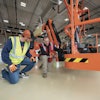So, what’s more important: retaining work…or workers? That was the question posed by a contractor in a discussion group I recently led… and boy, did it generate interest (and ire)!
In a perfect world the answer would be… “Both.” But as critical as it is to keep your workers, we can’t sacrifice the need to win and retain customers. In the final analysis – and contrary to many sincere and effective employee retention strategies – it is very important to win and retain work. (Oh boy, even I admit that this just doesn’t sound right.)
But with that in mind, here are a few work retention strategies that might also help you retain your workers.
1. Senior Leaders MUST Touch the Client. I’m almost ashamed to bring this first point up but I’ve witnessed fewer owners and senior leaders making the time to touch the client with a phone call, visit etc. While every contractor wants the client to really love his or her project team and crew, owners and/or senior leaders should make it a high priority to touch the client to reassure him of their awareness and commitment to him as a client.
2. Deliver a Documented Plan of Completing Work. For the General Contractor, this is a given. But for many specialty contractors, a written plan is not always required or preferred. For many smaller contractors a discussion about the job while standing around their work truck is about the extent of laying out the job. But no matter the size of project, a written plan should always be executed. This strategy is first and foremost a plan for the team tasked with completing the project. It’s never a bad idea to supply the client with your plan for execution.
3. Engage Your Workers to Plan & Share with Client. This strategy actually has multiple benefits. One, by engaging your workers to share in the planning you are creating smarter workers. Two, by engaging your workers you are allowing them to ask more questions and offer more ideas before they begin work. Third, by engaging your workers to share the plan with the client you are making the workers more important to the project and more important in the eyes of the client (i.e. Worker retention).
4. Develop Formal Client Follow-up Plan: 1-30-90-180 Day. This strategy takes more commitment and scheduling but it should none-the-less be considered a great strategy for client retention. The individual who was primarily involved with winning a project should re-engage the client upon its completion. This might be done on the actual day or the first day following. Then, he should plan to touch base with the client after the first 30 days to see how the customer is still enjoying the work. At 90 days, make another contact to see if there are any additional needs related to the completed project, then ask the client about future work or for referrals. Finally, at 180 days the contact might include inviting the client to take a tour of another completed project or involve the client in a Q&A discussion with other leaders in your company.
5. Share Opportunities that Client Might Engage. This strategy is focused more on those clients that might do other work and who might need pavement maintenance on other projects. For example, one contractor I work with has brought new development opportunities to a developer friend. In return, as some of the developments have materialized, the contractor has picked up additional work as a result of the developer’s efforts.
There are countless other ideas to retain your clients – even time-tested efforts as simple as giving away tickets to ballgames and sending holiday baskets of goodies.
So, is it more important to retain work or the worker? One serious consideration that every contractor will find himself or herself addressing is:
If I don’t have work then there is no need for workers.
We need to work hard today to keep our workers from leaving us for another opportunity. However, we can’t be so obsessed with employee retention that we take our eyes off the client, forgetting that it is the client who gives us the opportunity to retain workers. No work…no workers!
So make it a point as you gear up for 2015 to review your client retention efforts and rethink strategies that may very well strengthen our workload, backlog etc. Taking these steps will give you more confidence that you have the work to support workers who are also looking for security.
Brad Humphrey, president of Pinnacle Development Group, a consulting firm specializing in the construction industry, will present seven sessions at National Pavement Expo, Jan. 28-31 in Nashville, TN. For details visit www.nationalpavementexpo.com.



















